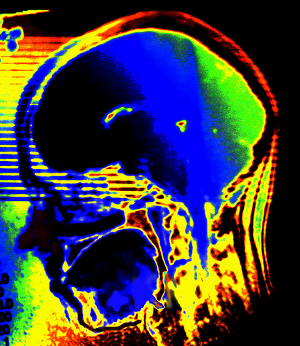MEDIA ROOTS- Ten years ago, the concept of visually mapping out one’s thoughts, dreams or memories seemed like far-fetched science fiction. Now, it’s a looming reality. UC Berkeley scientists have made a mind-blowing technological breakthrough by developing a system that collects visual activity in the human brain and roughly remodels it as digital video clips. After the process is perfected it will eventually lead to the reconstruction of dreams onto computers.
Abby
***
 GIZMODO– They used three different subjects for the experiments—incidentally,
they were part of the research team because it requires being inside
a functional Magnetic Resonance Imaging system for hours at a time.
The subjects were exposed to two different groups of Hollywood movie
trailers as the fMRI system recorded the brain’s blood flow through
their brains’ visual cortex.
GIZMODO– They used three different subjects for the experiments—incidentally,
they were part of the research team because it requires being inside
a functional Magnetic Resonance Imaging system for hours at a time.
The subjects were exposed to two different groups of Hollywood movie
trailers as the fMRI system recorded the brain’s blood flow through
their brains’ visual cortex.
The readings were fed into a computer program in which they were divided into three-dimensional pixels units called voxels (volumetric pixels). This process effectively decodes the brain signals generated by moving pictures, connecting the shape and motion information from the movies to specific brain actions. As the sessions progressed, the computer learned more and more about how the visual activity presented on the screen corresponded to the brain activity.
After recording this information, another group of clips was used to reconstruct the videos shown to the subjects. The computer analyzed 18 million seconds of random YouTube video, building a database of potential brain activity for each clip. From all these videos, the software picked the one hundred clips that caused a brain activity more similar to the ones the subject watched, combining them into one final movie. Although the resulting video is low resolution and blurry, it clearly matched the actual clips watched by the subjects.
Think about those 18 million seconds of random videos as a painter’s color palette. A painter sees a red rose in real life and tries to reproduce the color using the different kinds of reds available in his palette, combining them to match what he’s seeing. The software is the painter and the 18 million seconds of random video is its color palette. It analyzes how the brain reacts to certain stimuli, compares it to the brain reactions to the 18-million-second palette, and picks what more closely matches those brain reactions. Then it combines the clips into a new one that duplicates what the subject was seeing. Notice that the 18 million seconds of motion video are not what the subject is seeing. They are random bits used just to compose the brain image.
Given a big enough database of video material and enough computing power, the system would be able to re-create any images in your brain.
Read more about Scientists Reconstruct Brains’ Visions Into Digital Video In Historic Experiment
© 2011 Gizmodo
Video comparing reconstructed clips from human brain activity compared to actual images shown
Photo by Flickr user alles-schlumpf










